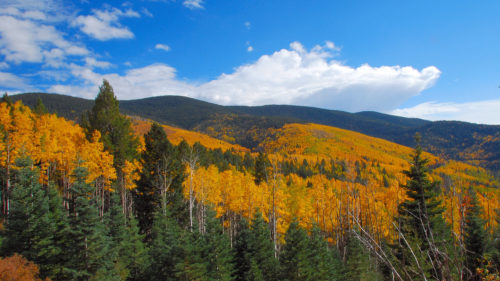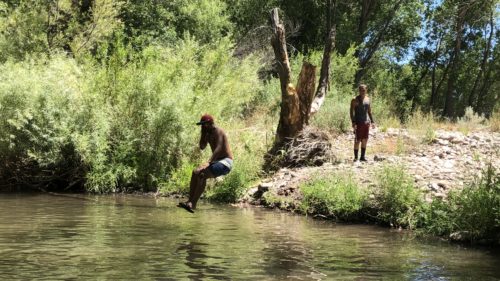New Mexico Wildlife Federation Public Comments
Whitewater Creek Gila Trout Restoration
To: Dustin Myers, c/o Anne Casey, Glenwood Ranger District
From: Andrew Black & Gabe Vasquez, New Mexico Wildlife Federation
Re: Whitewater Creek Gila Trout Restoration
Date: March 13, 2017
As New Mexico’s oldest sportsmen conservation organization with over 80,000 members statewide, the New Mexico Wildlife Federation would like to state our support for “Environmental Assessment Alternative One,” to restore Gila trout and other native fishes to Whitewater Creek.
As one of the Southwest’s most iconic species, the Gila trout (Oncorhynchus gilae gilae) represents a distinct and important evolutionary line of fish that is unique to the American west. Believed to have entered the Gila basin during the mid-Pleistocene, between 500,000 to 1 million years ago, scientists and anglers alike have lauded the importance of the Gila trout as an ancient fish with primitive and unique genetic traits and characteristics that developed in relative isolation.[i] As a fish native to our region, the Gila trout is a species of critical importance not only to evolution and ecology of the desert southwest, but also to the history and cultural identity of the region. Native American tribes have long recognized the cultural and ecological importance of the Gila trout while early western settlers affectionately described the fish as “yellow bellies,” noting its distinctive coloration and spotting.
Featured on ESPN, the Gila basin has also been a noted tourist destination for anglers traveling from throughout the United States in order to catch one of these storied fish that embodies the diverse histories, cultures and traditions of the American southwest.[ii] Accordingly, restoration of the Gila trout and other native species to Whitewater Creek not only is important to the biological, historical, social and cultural identity of New Mexico, but also is an important economic driver to the region since anglers and outdoor enthusiasts will travel thousands of miles just to catch (or catch a glimpse of) this specific species. Along these lines, while there are many places for anglers to catch rainbows, browns and brook trout throughout New Mexico, opportunities to catch the iconic Gila trout are rare and specifically limited to this distinctive region.
Although it is a species of incredible significance, the Gila trout is limited to a relatively small range of isolated and unstable high desert streams that have severely restricted the fish’s population. Further, threats to the Gila trout and its habitat remain immense and survival of the Gila trout requires intentional protection of the species and specific habitat restoration work such as the one being proposed on Whitewater Creek under “Environmental Assessment Alternative One.” Speaking to the importance of this restoration work is the fact that “the widespread introduction of brook, brown and rainbow trout and loss of habitat due to livestock grazing, logging, road construction and diversion of water from streams have drastically affected the native range” of the Gila trout and it is estimated that 95% of the Gila trout’s habitat has been lost.[iii] Although the Gila trout is known to be an adaptive and resilient fish with an innate instinct for survival, habitat loss, drought and climate change and catastrophic fires, such as the Whitewater-Baldly fire, have had devastating effects on the Gila trout population. Accordingly, efforts to restore Gila trout to Whitewater Creek under Alternative One are essential to establishing a viable, resilient and self-sustaining population.
As an organization that works ensure public access to public lands, the New Mexico Wildlife Federation also wants to lift up the importance within Alternative One of reconstruction and maintenance of trails to provide increased public access to this beautiful, rugged and unique terrain. Further, we deeply appreciate that recreational angling has been considered in planning of this project and want to continue to lift up the significant positive economic benefits for the region and for our state that will result from restoring this fishery featuring native Gila trout.
For the many reasons stated above, we want to strongly encourage the USFS to select “Environmental Assessment Alternative One,” to restore Gila trout and other native fishes to Whitewater Creek. Thank you for your time and consideration and we look forward to our continued work together.
Sincerely,
Andrew Black
Director of Community Relations, Education, & Veterans Outreach
New Mexico Wildlife Federation
Gabe Vasquez
Southern New Mexico Outreach Coordinator
New Mexico Wildlife Federation
[i] See Robert J. Behnke, Trout and Salmon of North America (The Free Press: New York, 2002), 126; see also Bill Willers, Trout Biology: A Natural History of Trout and Salmon (Lyons & Burford: New York, 1991), 12-13.
[ii] Gary Giudice, Gila Trout: More Fishing Than Catching at: http://www.espn.com/outdoors/fishing/news/story?id=4272512, July 9, 2009, (accessed 3/13/17).
[iii] See Behnke, supra note 1, 125-26.



